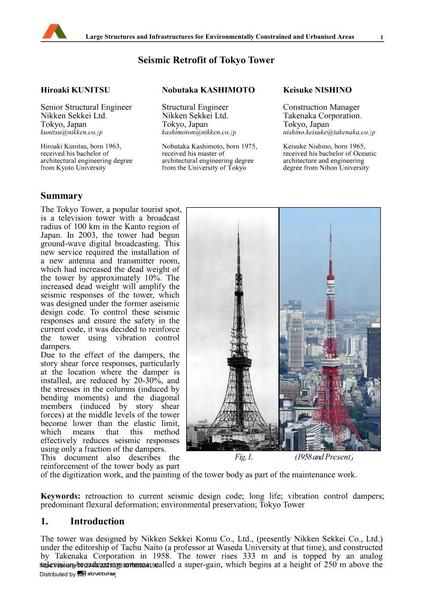Seismic Retrofit of Tokyo Tower

|
|
|||||||||||
Détails bibliographiques
| Auteur(s): |
Hiroaki Kunitsu
Nobutaka Kashimoto Keisuke Nishino |
||||
|---|---|---|---|---|---|
| Médium: | papier de conférence | ||||
| Langue(s): | anglais | ||||
| Conférence: | IABSE Symposium: Large Structures and Infrastructures for Environmentally Constrained and Urbanised Areas, Venice, Italy, 22-24 September 2010 | ||||
| Publié dans: | IABSE Symposium Venice 2010 | ||||
|
|||||
| Page(s): | 194-195 | ||||
| Nombre total de pages (du PDF): | 8 | ||||
| Année: | 2010 | ||||
| DOI: | 10.2749/222137810796024196 | ||||
| Abstrait: |
The Tokyo Tower, a popular tourist spot, is a television tower with a broadcast radius of 100 km in the Kanto region of Japan. In 2003, the tower had begun ground-wave digital broadcasting. This new service required the installation of a new antenna and transmitter room, which had increased the dead weight of the tower by approximately 10%. The increased dead weight will amplify the seismic responses of the tower, which was designed under the former aseismic design code. To control these seismic responses and ensure the safety in the current code, it was decided to reinforce the tower using vibration control dampers. Due to the effect of the dampers, the story shear force responses, particularly at the location where the damper is installed, are reduced by 20-30%, and the stresses in the columns (induced by bending moments) and the diagonal members (induced by story shear forces) at the middle levels of the tower become lower than the elastic limit, which means that this method effectively reduces seismic responses using only a fraction of the dampers. This document also describes the reinforcement of the tower body as part Fig. 1. (1958 and Present) of the digitization work, and the painting of the tower body as part of the maintenance work. |
||||
